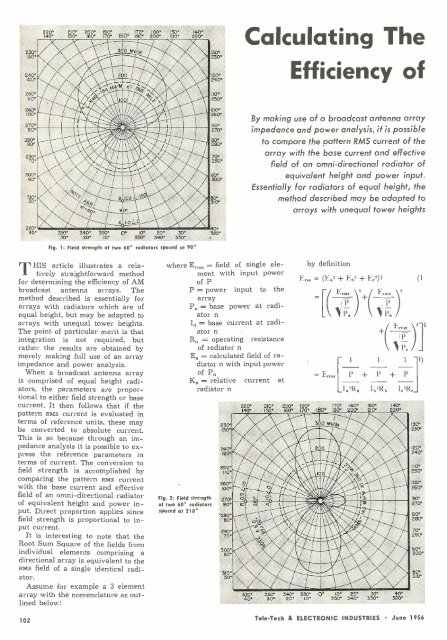TELE-TECH & - AmericanRadioHistory.Com
TELE-TECH & - AmericanRadioHistory.Com
TELE-TECH & - AmericanRadioHistory.Com
Create successful ePaper yourself
Turn your PDF publications into a flip-book with our unique Google optimized e-Paper software.
. -. ' _<br />
220° 210° 200 190° 170° 160° 150°<br />
140° 150° 160° 170° 180° 190° 200° 210° 240°<br />
'..,,<br />
230°<br />
300 MV/61 130°<br />
130°<br />
,4<br />
230°<br />
240°<br />
120°<br />
2.0<br />
250° ,*tat*.<br />
__ p<br />
120°<br />
`' ,I'..!<br />
240°<br />
I<br />
110°<br />
110°<br />
,``,'=Q.<br />
250°<br />
+i1.:0<br />
260°<br />
100 °'<br />
100°<br />
....<br />
260°<br />
270°<br />
90°<br />
90°<br />
9/I1<br />
280°<br />
1=s1 y1<br />
270°<br />
80°<br />
80°<br />
280°<br />
290°<br />
. .<br />
70°<br />
70°<br />
290°<br />
,<br />
300°<br />
60°<br />
33000°<br />
10<br />
4.<br />
77F<br />
310°<br />
/<br />
50°<br />
=<br />
7y°<br />
9o. 90'<br />
.L0,.....í.A<br />
320°<br />
40° 330° 340° 350° 0° 10° 20° 30° 320°<br />
30° 20° 10° 350° 340° 330°<br />
,. iu.<br />
Fig. 1: Field strength of two 60' radiators spaced at 90°<br />
Calculating The<br />
Efficiency of<br />
By making use of a broadcast antenna array<br />
impedance and power analysis, it is possible<br />
to compare the pattern RMS current of the<br />
array with the base current and effective<br />
field of an omni -directional radiator of<br />
equivalent height and power input.<br />
Essentially for radiators of equal height, the<br />
method described may be adapted to<br />
arrays with unequal tower heights<br />
THIS article illustrates a relatively<br />
straightforward method<br />
for determining the efficiency of AM<br />
broadcast antenna arrays. The<br />
method described is essentially for<br />
arrays with radiators which are of<br />
equal height, but may be adapted to<br />
arrays with unequal tower heights.<br />
The point of particular merit is that<br />
integration is not required, but<br />
rather the results are obtained by<br />
merely making full use of an array<br />
impedance and power analysis.<br />
When a broadcast antenna array<br />
is comprised of equal height radiators,<br />
the parameters are proportional<br />
to either field strength or base<br />
current. It then follows that if the<br />
pattern RMS current is evaluated in<br />
terms of reference units, these may<br />
be converted to absolute current.<br />
This is so because through an impedance<br />
analysis it is possible to express<br />
the reference parameters in<br />
terms of current. The conversion to<br />
field strength is accomplished by<br />
comparing the pattern RMS current<br />
with the base current and effective<br />
field of an omni -directional radiator<br />
of equivalent height and power input.<br />
Direct proportion applies since<br />
field strength is proportional to input<br />
current.<br />
It is interesting to note that the<br />
Root Sum Square of the fields from<br />
individual elements comprising a<br />
directional array is equivalent to the<br />
RMS field of a single identical radiator.<br />
Assume for example a 3 element<br />
array with the nomenclature as outlined<br />
below:<br />
102<br />
where E.5 = field of single element<br />
with input power<br />
of P<br />
P = power input to the<br />
array<br />
Pa = base power at radiator<br />
n<br />
In = base current at radiator<br />
n<br />
Rn = operating resistance<br />
of radiator n<br />
En = calculated field of radiator<br />
n with input power<br />
of Pn<br />
Kn = relative current at<br />
radiator n<br />
Fig. 2: Field strength<br />
of two 60' radiators<br />
spaced at 210'<br />
130<br />
250°<br />
110'<br />
100'<br />
270°<br />
280°<br />
80°<br />
290°<br />
70°<br />
300°<br />
60°<br />
310°<br />
50°<br />
by definition<br />
Er.. = (E; + E6" + E°-) (1<br />
C<br />
E<br />
rm.<br />
)=+(<br />
E .m.<br />
)<br />
P./ \ P6/<br />
Erm \214<br />
P<br />
P°<br />
1 1 1 1<br />
=E. i + P+ P 1<br />
220° 210° 200° 190° 170° 160° 150° 140°<br />
140° 150° 160° 170° 180° 190° 200° 210°<br />
320° 330' 340° 350°<br />
40° 30° 20° 10°<br />
Li<br />
° 10° 20° 30°<br />
350° 340° 330°<br />
40°<br />
320°<br />
130°<br />
230°<br />
120°<br />
240°<br />
110°<br />
250°<br />
100°<br />
260°<br />
90°<br />
270°<br />
80°<br />
280°<br />
70°<br />
290°<br />
60°<br />
300°<br />
50°<br />
310°<br />
Tele -Tech & ELECTRONIC INDUSTRIES June 1956
















